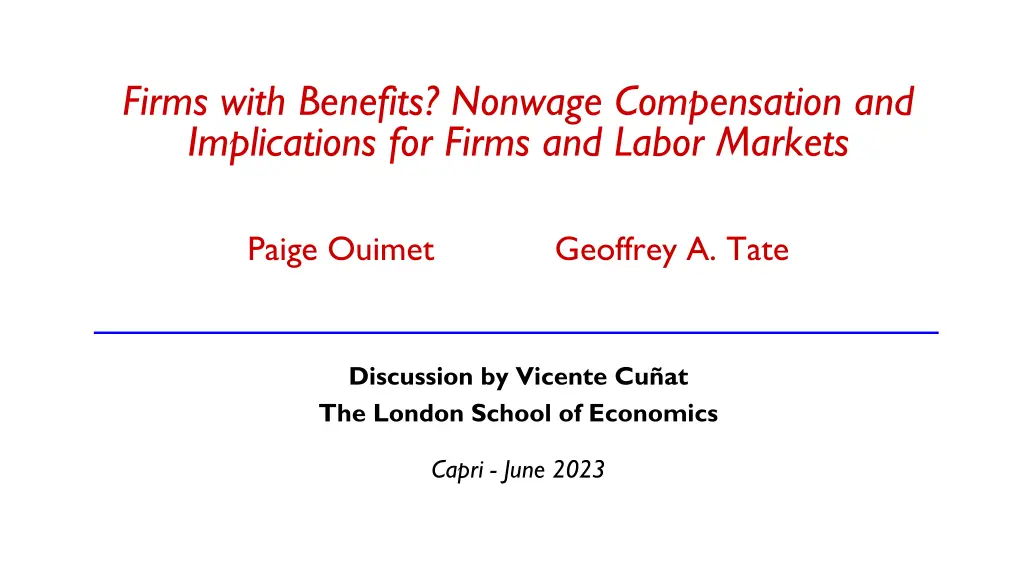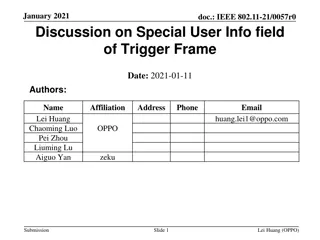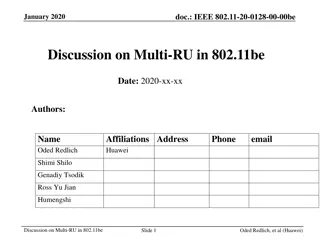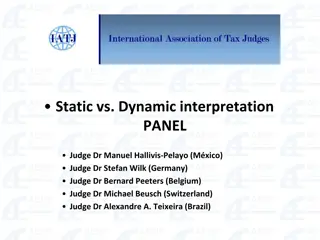
Understanding Nonwage Benefits Distribution in Firms
Discover the implications of nonwage benefits distribution within and between firms regarding wage distribution, employment composition, retention, and performance. Analyze variance decomposition of wages and benefits using an IV strategy with peer firms' benefits.
Download Presentation

Please find below an Image/Link to download the presentation.
The content on the website is provided AS IS for your information and personal use only. It may not be sold, licensed, or shared on other websites without obtaining consent from the author. If you encounter any issues during the download, it is possible that the publisher has removed the file from their server.
You are allowed to download the files provided on this website for personal or commercial use, subject to the condition that they are used lawfully. All files are the property of their respective owners.
The content on the website is provided AS IS for your information and personal use only. It may not be sold, licensed, or shared on other websites without obtaining consent from the author.
E N D
Presentation Transcript
Firms with Benefits? Nonwage Compensation and Implications for Firms and Labor Markets Paige Ouimet Geoffrey A. Tate Discussion by Vicente Cu at The London School of Economics Capri - June 2023
Summary of the paper - Setup Objectives: Study the distribution of non-wage benefits within and between firms Implications of benefit distortions (taxes, non-discrimination, contagion ) on: Within firm wage distribution Employment composition Retention Performance Approach: Compute non-wage benefits as health, retirement and leave benefits Variance decomposition of wages and benefits IV strategy using peer firms benefits
Summary of the paper - Results Variance decomposition Relative to wages, non-wage benefits vary more between firms and less within firms. Low-wage workers in high-skill firms get more benefits than in low-skill firms. Turnover High non-wage benefit firms rely less on low-wage workers High benefits, predict lower departures, particularly among low-wage workers Performance Firms with relatively more generous benefits tend to have lower market valuation ratios
A minimal analytical setting I One firm, one worker A firm sets up a wage W and benefit B for its only worker. Abstract from extensive margin. W and B are chosen to maximize product Y (efficiency wages, retention, better selection) Labor is measured in ex-ante $ - Efficiency units. Incentives are additive Y=F(W)+G(B) In equilibrium F (W) = G (B)=1 One firm, two types of worker There is a fraction of high-skill workers (h) and a fraction (1- ) of low-skill workers (l) In equilibrium Fh (Wh) = Gh (Bh) = Fl (Wl) = Gl (Bl)=1 This does not deliver the paper s results. Let s introduce some constraints
Constraint 1 Benefits have to be equal across types (fairness regulation) One firm, two types of worker, Constraint 1 (Bh = Bl) There is a fraction of high-skill workers (h) and a fraction (1- ) of low-skill workers (l) In equilibrium Y (Wh) = Y (Wl) = ( Yh (B) + (1- ) Yl (B)) =1 Low-skilled (high-skilled) workers have higher (lower) benefits than in unconstrained case Wh and Wl unchanged Link to empirical results Within-firm variance of B is lower than that of W Between firm variance of B higher than within firm High between establishment variance of benefits (driven by ) If turnover is a by-product, higher reduces turnover of all workers Firm profits and worker benefits not correlated We need more structure
Adding participation constraints and downward wage rigidites. One firm, two types of worker, Constraint 1 (Bh = Bl) Substitute incentives with a binding participation constraint Wh and Bh become linked E.g., Wh + Wl > C Wh and Wl should accommodate for the effect of Bh = Bl Add downward wage rigidities such as minimum wages or saliency of wages Wh but Wl is fixed Wh growing in (1- ) (although, empirically, many confounding factors) Link to empirical results Low skilled workers overpaid, growing in , low turnaround High skilled workers fairly paid normal turnaround, independent of Overall cost higher than in unconstrained case Firm profits and worker benefits not correlated
Constraint II Benefits need to be equal across peer firms (Bh = Bl = Bpeer) One firm, two types of worker, Constraint 1 and Constraint II (Bh = Bl = Bpeer) Incentives model In equilibrium Y (Wh) = Y (Wl) = 1 and ( Yh (B) + (1- ) Yl (B)) 1 Participation as a by-product Firms with higher Bpeer, lower turnaround Overall cost too high for some, about right for others Firm performance is lower than in unconstrained case Firm performance uncorrelated with Bpeer Relax the constraint Bh = Bl > Bpeer Firm performance negatively correlated with Bpeer
Summing up Some results are easier to model than other, each result has different implications for the labor market. A constraint that makes benefits similar across workers of a firm Delivers variance decomposition results Equalization of benefits alone would not deliver retention results Participation constraints With flexible wages Do not deliver retention results With downward rigidities or imperfect substitution of wages and benefits Deliver retention returns Firm peer effects Deliver participation results With symmetric peer effects Higher peer benefits do not lead to lower performance. With asymmetric peer effects Higher peer benefits lead to lower performance.
The paper can be summarized as the effects of: 1) Within firm contagion of benefit provision (legal and peer effects). II) Between firm contagion of benefit provision One of the effect of interest A source of exogenous variation Between-firm similarity of benefits can come from different sources Labor market competition (preferred paper explanation). Broader peer effects Firm similarity on other dimensions (e.g., fraction of high-skilled workers) 1. 2. 3. From an identification perspective 3 could be problematic, but also interesting as an effect.
Interaction with total pay. Variance decomposition of benefits is unitless. Is it the only interesting unit? How about measuring the effect directly in total compensation dollars or % of total pay? Relative size of pay and benefits becomes relevant It makes turnover results of low-pay workers easier to understand. Is turnover the same across pay bins if benefits are put as a % of the wage? Ex-ante vs. ex-post dollars seem important. Can something quantitative be said about these?
Wages are also prone to contagion, what is special to benefits? Within-firm legal restrictions of fairness. The saliency of wages and benefits may be different at hiring or retaining decisions Wages may be more salient when hiring and benefits more salient for retention Potential rationales for wages not fully compensating for wages Testable implications for firms with exogenously high/low benefits The effects of the paper should interact with some demographics. Age to retirement, health and disabilities Eligibility for publicly provided health These should have effects within firms across levels of benefits.
Summary Conclusions Really nice paper! Interesting topic, nicely executed. Goes from facts, to mechanisms to performance. Contagion of benefits within and between firms and the inability of wages to compensate The paper has a rich implicit structure. What do we learn a lot about labor markets beyond benefits? Which results require more or less frictions? Interesting to know about benefits, but also helps us understand the labor market as a whole






















